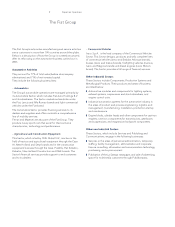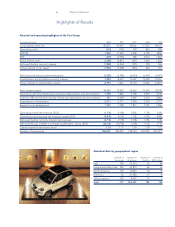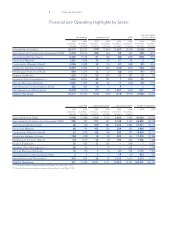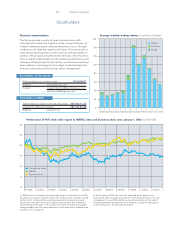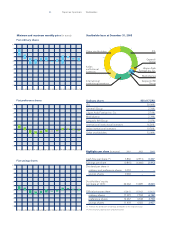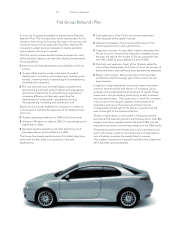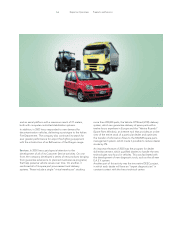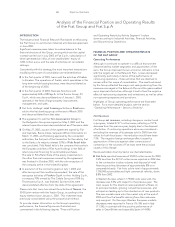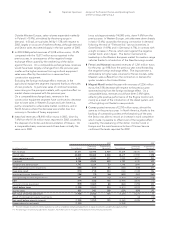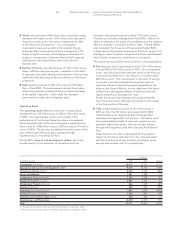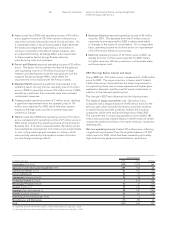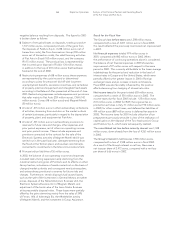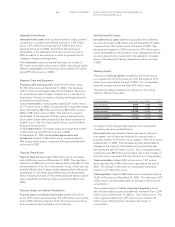Chrysler 2003 Annual Report Download - page 18
Download and view the complete annual report
Please find page 18 of the 2003 Chrysler annual report below. You can navigate through the pages in the report by either clicking on the pages listed below, or by using the keyword search tool below to find specific information within the annual report.
17 Report on Operations
Environment
In 2003, the Fiat Group Sectors put a range of products on
the market whose environmental impact was lower than ever
before in all three key areas of fuel economy, emissions control
and efficiency. Corresponding improvements were made in
manufacturing processes. For both products and processes,
these achievements stem from the kind of innovation that can
only be made possible by continuing research.
The Group’s research work, so essential to developing effective,
competitive technologies, is spearheaded by the Fiat Research
Center, Elasis, and the Center for the Study of Transportation
Systems.
Major achievements and initiatives in 2003 are detailed in
the Environmental Report, submitted together with the
Fiat Group’s Annual Report for the twelfth year running. A
few of the highlights of the past year are illustrated below:
❚Traditional Engines. Product engineering work was completed
on the 1.3-liter 16-valve Multijet diesel engine, which already
meets Europe’s future emissions limits. The new powerplant
has been installed on innovative cars such as the Ypsilon, Idea
and Panda.
Iveco started testing of its new V-6, V-12 and V-16 diesel
engines, as well as its new Cursor engine for the US market,
which also complies with the upcoming Euro 4 standards. The
new medium Eurocargo truck was also introduced in 2003.
This unit’s new Tector engine, which boasts low emissions and
fuel consumption, has been developed in 3-, 4- and 6-cylinder
configurations for application on agricultural and construction
equipment, also with the aim of meeting the new standard
requirements of the US market.
❚Natural Gas-Powered Vehicles. NGVs continued to gain
ground, thanks in no small measure to the Group’s foresight
in providing buyers with the most complete lineup of natural
gas vehicles on the market today. This range was further
extended in 2003 with the introduction of the Punto Natural
Power, while production of the ultra-low emissions 6-cylinder
Tector and Cursor engines designed for busses and
city-dwelling trucks also got under way.
❚Agricultural and Construction Equipment. New Holland
and Case used common platforms to renew almost half of
the models in the two makers’ ranges of agricultural and
construction equipment. All of the new machines are significantly
more compatible with the environment than their predecessors.
Renewal of both ranges will be completed in 2004.
❚Electric and Hybrid Propulsion Systems. In 2003, earlier
prototype vehicles were joined by the new Panda
“Hydrogen”. Further advances were also made in public
transit applications, where trials are now being carried out
on two new fuel cell-powered busses in Turin and Madrid.
❚Production processes. The Fiat Research Center continued to
work with Sectors on dry machining process that will reduce
cutting fluid usage, thus bringing down costs and improving
environmental performance. For its part, the Fiat Research
Center stepped up its testing of alternative fibers which will
make a major contribution to reducing overall vehicle weight.
❚Ongoing process improvements. Thanks to the extension
of the Group’s environmental management systems and
the continuous improvement programs implemented at its
production processes, 2003 witnessed further increases in our
waste recycling performance, with the percentage of waste
sent to controlled landfills dropping yet again. Volatile organic
compound (VOC) solvent emissions from Fiat Auto, CNH and
Iveco paint shops were also reduced.
Overview of the main environmental achievements of the Fiat
Group’s Italian industrial facilities over more than a decade
1991 2002 2003
Recycled waste 61.0% 77.8% 82.8%
Waste to controlled landfills 37.0% 7.6% 7.4%
Solvent emissions
from paint shops (g/m2) 144.0 77.4 72.4


